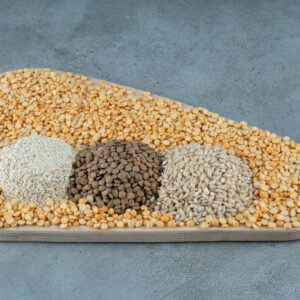Have you ever wondered what happens inside a flour mill before that perfect wheat flour reaches your kitchen shelf?
If you’ve ever visited a traditional atta chakki or watched modern flour mills in action, you’ll notice massive steel rollers working tirelessly to transform wheat grains into fine flour. But here’s what most people don’t know: there are actually two completely different types of rollers doing very different jobs in the wheat milling process. Today, I’m going to break down the fascinating world of break rolls in wheat vs. reduction rolls and help you understand which one truly makes the bigger difference in your flour quality. By the end of this post, you’ll know exactly how these systems work, why both matter, and which one has the edge when it comes to producing that perfect flour.
Understanding the Wheat Milling Journey
Before we dive into the break rolls vs. reduction rolls debate, let’s quickly understand how wheat becomes flour. The modern wheat milling process isn’t just about crushing grains between two stones anymore. It’s a sophisticated process where wheat passes through two cast steel “break” rollers which are set slightly apart from each other, with the top roller running at a slightly faster rate to create a shearing action that opens up the wheat grain. Think of it like peeling an orange in layers you want to separate each part cleanly without damaging what’s inside.
The whole process involves multiple stages:
- Cleaning and conditioning the wheat
- Breaking the grain structure
- Sifting and purifying the particles
- Reducing endosperm pieces into flour
Each stage requires different types of rollers, and that’s where our main players come in.
What Are Break Rolls in Wheat Milling?
The Heavy-Duty Opener
Break rolls are the first heroes in our wheat milling story. These are fluted (corrugated) steel rollers that work like a tag team to crack open wheat grains. Thanks to a combination of shear, friction/abrasion and impact forces, the grain or kernel is broken/fractionated into wide particle-sized pieces during distribution, separating the endosperm from the bran and germ components.
How Break Rolls Work
Imagine trying to open a walnut. You don’t want to smash it completely, you want to crack the shell cleanly so you can extract the meat inside without damage. That’s exactly what break rolls do to wheat grains.
Key characteristics of break rolls:
- Fluted surface with sharp ridges
- Different speeds (differential speed ratio)
- Gradual pressure increase through multiple passages
- Focus on separation rather than grinding
The magic happens when wheat passes between these rollers. The faster top roller and slower bottom roller create a shearing action that opens up the grain structure without pulverising it completely.
The Break System Process
Most modern mills use 4-5 break passages, each getting progressively finer.
First Break (1B): Opens the wheat grain, separates large bran pieces Second Break (2B): Further breaks down remaining pieces Third Break (3B): Extracts more endosperm from bran Fourth Break (4B): Final extraction from stubborn particles
After each break passage, the material goes through sieves to separate different-sized particles. It’s like sorting dal at home you’re separating the good stuff from the husks and broken pieces.
What Are Reduction Rolls and How Do They Function?
The Precision Grinders
Now comes the second act of our wheat milling drama, the reduction rolls. The reduction system follows the break system and involves smooth rolls that grind purified semolina and middlings into fine flour, designed to minimize bran contamination in the flour. If break rolls are the door-openers, reduction rolls are the precision artists.
The Smooth Operators
Unlike their fluted cousins, reduction rolls have smooth surfaces. They work under higher pressure but at lower speed differentials (around 1.25:1 ratio). This step reduces the endosperm pieces (known as middlings) to flour.
Key features of reduction rolls:
- Smooth steel surfaces for fine grinding
- Higher pressure application
- Lower speed differentials
- Progressive size reduction
The Reduction System Journey
The reduction system typically has 6-8 passages, each producing finer flour.
First Reduction (1R): Grinds large semolina particles Second Reduction (2R): Further reduces particle size Third Reduction (3R): Creates fine flour streams Subsequent Reductions: Progressively finer grinding
Between each passage, purifiers remove any remaining bran specks to ensure clean, white flour. Think of it like making perfect besan from chana dal you keep grinding until you get that silky-smooth texture.
Break Rolls vs. Reduction Rolls: The Key Differences
Let me put this in a simple comparison that makes sense:
Purpose and Function
Break Rolls:
- Primary job: Opening and separating
- Target: Wheat grain structure
- Goal: Clean separation of endosperm, bran, and germ
Reduction Rolls:
- Primary job: Grinding and refining
- Target: Purified endosperm pieces
- Goal: Fine flour production
Surface Design
Break Rolls:
- Fluted/corrugated surfaces
- Sharp cutting edges
- Designed for tearing action
Reduction Rolls:
- Smooth steel surfaces
- Polished finish
- Designed for compressive grinding
Speed and Pressure
Break Rolls:
- Higher speed differentials (2.5:1 to 1.5:1)
- Moderate pressure
- Emphasis on shearing action
Reduction Rolls:
- Lower speed differentials (1.25:1)
- Higher pressure
- Emphasis on compression
Which System Matters More: The Verdict
Here’s the truth that might surprise you both systems are absolutely critical, but they matter for different reasons.
Why Break Rolls Are Crucial
Without proper break roll operation, you’ll face:
- Poor endosperm extraction
- Excessive bran contamination
- Reduced flour yield
- Compromised nutritional separation
Break system flours have different characteristics while sizing and reduction system flours have a more interesting nutritional profile. The break system determines how much good flour you can extract from your wheat. It’s like the foundation of a building get this wrong, and everything else suffers.
Why Reduction Rolls Are Essential
The reduction system determines what quality flour you produce.
Poor reduction roll operation leads to:
- Coarse flour texture
- Inconsistent particle size
- Reduced baking performance
- Poor consumer acceptance
The Real Answer
If I had to choose which matters more, I’d say break rolls have the edge because:
- They determine your overall yield from wheat
- They set the stage for everything that follows
- Poor breaking cannot be fixed by good reduction
- They impact economics more directly
But here’s the catch you simply cannot succeed without both systems working in harmony. It’s like asking whether the engine or wheels matter more in a car. You need both, but the engine (break rolls) determines how far you can go.
Real-World Impact on Indian Mills
In the Indian context, where we process diverse wheat varieties from Punjab, Haryana, MP, and other states, both systems face unique challenges.
Hard wheat varieties (like PBW 343) require aggressive break roll settings but gentle reduction.
Soft wheat varieties need different break parameters but can handle more intensive reduction.
Most modern Indian flour mills now use:
- 4-5 break passages with automated gap control
- 6-8 reduction passages with pneumatic pressure systems
- Advanced purifiers between systems
- Real-time moisture monitoring
This technology helps achieve consistent quality whether you’re producing maida, atta, or specialty flours.
Optimising Both Systems for Better Results
Break Roll Optimisation Tips
Roll surface maintenance:
- Regular fluting renewal every 6-8 months
- Proper alignment and gap settings
- Temperature monitoring during operation
Process parameters:
- Wheat moisture content: 15.5-16% for optimal breaking
- Speed differentials based on wheat hardness
- Gradual gap reduction across passages
Reduction Roll Optimisation
Surface quality:
- Mirror-smooth finish maintenance
- Regular cleaning and polishing
- Pressure distribution monitoring
Operating conditions:
- Progressive pressure increase
- Temperature control to prevent overheating
- Consistent feed rate maintenance
The Technology Evolution
The wheat milling industry has seen remarkable advances in both break and reduction roll technology.
Modern break rolls feature:
- CNC-machined fluting patterns
- Differential hardness surfaces
- Automatic gap adjustment systems
Advanced reduction rolls include:
- Chrome-plated surfaces
- Micro-fine finishing
- Pneumatic pressure control
- Real-time monitoring systems
These improvements have made both systems more efficient and consistent.
Cost-Benefit Analysis
From an investment perspective, both systems require significant capital.
Break roll systems typically cost:
- ₹15-25 lakhs for a complete 4-passage system
- Annual maintenance: ₹2-3 lakhs
- Fluting renewal: ₹50,000-1 lakh per passage
Reduction roll systems cost:
- ₹20-30 lakhs for a 6-passage system
- Annual maintenance: ₹1.5-2.5 lakhs
- Surface refinishing: ₹30,000-50,000 per passage
The ROI comes from improved yield and quality, making both investments essential for commercial success.
Common Problems and Solutions
Break Roll Issues
Problem: Excessive flour production in break system Solution: Adjust gap settings and speed differentials
Problem: Poor bran separation Solution: Check fluting sharpness and wheat conditioning
Reduction Roll Issues
Problem: Coarse flour from reduction system Solution: Increase pressure gradually and check surface smoothness
Problem: Overheating during reduction Solution: Monitor feed rates and install cooling systems
Future Trends in Roll Technology
The milling industry is moving towards:
- AI-powered gap control systems
- Predictive maintenance using sensors
- Energy-efficient motor systems
- Automated quality monitoring
Both break and reduction roll systems are benefiting from these technological advances.
Making the Right Choice for Your Mill
When setting up or upgrading a wheat mill, consider:
For small-scale operations (1-5 TPD):
- Focus on reliable break roll systems first
- Invest in quality reduction rolls for premium products
For medium-scale mills (5-20 TPD):
- Balance investment between both systems
- Prioritise automation and monitoring
For large-scale mills (20+ TPD):
- Invest in cutting-edge technology for both systems
- Focus on energy efficiency and maintenance ease
Conclusion
So, which matters more break rolls in wheat milling or reduction rolls?
The truth is, both are indispensable partners in the quest for perfect flour. Break rolls determine how much flour you can extract and set the foundation for quality. Reduction rolls determine what quality flour you produce and ensure consumer satisfaction. If forced to prioritise, break rolls have a slight edge because they control the fundamental separation process and overall yield. But the real success comes from optimising both systems to work in perfect harmony.
Whether you’re running a small chakki or managing a large commercial mill, CMS Industries recommends investing in quality break rolls and reduction rolls, maintaining them properly, and understanding their unique roles because these factors will ultimately determine your success.
After all, great flour doesn’t happen by accident it’s the result of precision engineering in both break rolls in wheat vs. reduction rolls working together seamlessly.
Frequently Asked Questions
Q1: What’s the main difference between break rolls and reduction rolls in wheat milling?
Break rolls have fluted surfaces and open wheat grains through shearing action, while reduction rolls have smooth surfaces and grind purified endosperm into fine flour through compression.
Q2: Can a mill operate with only break rolls or only reduction rolls?
No, both systems are essential. Break rolls separate grain components, while reduction rolls create the final flour. Neither can function effectively without the other in modern milling.
Q3: How often should break rolls and reduction rolls be maintained?
Break rolls need fluting renewal every 6-8 months, while reduction rolls require surface refinishing every 8-12 months. Regular cleaning and gap adjustments are needed weekly.
Q4: Which roll system has higher operating costs?
Break rolls typically have higher maintenance costs due to fluting wear, while reduction rolls have lower maintenance but require precision surface finishing, making overall costs comparable.
Q5: How do I know if my break rolls or reduction rolls need replacement?
Signs include declining flour yield (break rolls), coarse flour texture (reduction rolls), excessive power consumption, unusual noise, or visible surface damage on the rollers.





